Daisosho SEN Genshitsu in China Twice for the 40th Anniversary
of the China-Japan Treaty of Peace and Friendship
of the China-Japan Treaty of Peace and Friendship
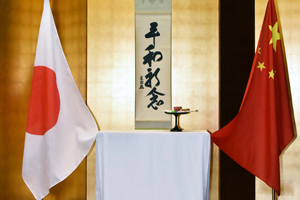 |
| The year 2018 marks the 40th year since, in August of 1978, six years after the normalization of diplomatic relations between China and Japan, the two countries signed their China-Japan Treaty of Peace and Friendship. That event took place in Beijing, and then, in October of the same year, in Tokyo, a formal ceremony was held to exchange the instruments of ratification of the Treaty. Representing China at the ceremony was then Vice Premier DENG Xiaoping (Jp., TOU Shohei), who made the visit to Japan at the invitation of the Japanese government, and who thereby became the first state leader of the People's Republic of China to visit Japan. He was in Japan with his wife, and they took an excursion by Shinkansen to Kyoto, where, among other things, they met with the then Urasenke Iemoto XV, now known as Daisosho SEN Genshitsu, who made tea for them. Ever since that meeting, Daisosho has poured immense energy and resources into promoting the Treaty's intentions, and has made numerous trips to China. They include a trip in April and another in May this year, to take part in activities commemorating the 40th anniversary of the China-Japan Treaty. |
| Friendship Chakai in Beijing The trip in April was from the 16th to the 18th, and was by invitation of the China-Japan Friendship Association (CJFA), who planned to hold a China-Japan Spring Friendship Chakai commemorating the anniversary of the Treaty. |
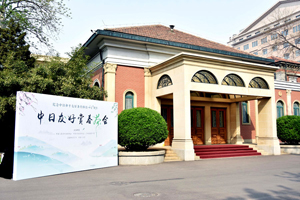 |
| The Chakai took place on April 17th, at the compound of the Chinese People's Association for Friendship with Foreign Countries (CPAFFC), where the CJFA has quarters. Arriving there, Daisosho met with CJFA President TANG Jiaxuan and prepared a bowl of matcha for him in a bonryaku style of tea making. Members of Daisosho's Urasenke entourage brought bowls of matcha in to the others who were at this meeting. |
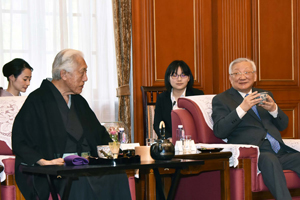 |
Everyone then moved to the auditorium, where Daisosho would conduct a kencha-shiki (tea dedication ceremony). Vice President SONG Jingwu of the CPAFFC delivered an opening address for the kencha-shiki, impressing upon the attendees the significance of this ceremony. Daisosho sat at the tenchaban tea-making table which had been arranged on the stage, solemnly prepared a bowl of matcha, and placed it on the offering table which stood before a hanging scroll bearing calligraphy by Daisosho which read  (Peace Prayer). To its sides were the flags of Japan and China. At the end, Daisosho addressed the attendees, saying that he prays that China and Japan might overcome their various issues and together contribute towards a splendid world. Minister SHIKATA Noriyuki of the Embassy of Japan in China made a speech, saying that he held hopes that this day's Chakai would help deepen China and Japan's understanding of their mutual culture and strengthen their appreciation of their bonds. LIU Deyou, China's former Vice Minister of Culture, delivered a short talk entitled "Tea: Bonding Chinese and Japanese Culture."
(Peace Prayer). To its sides were the flags of Japan and China. At the end, Daisosho addressed the attendees, saying that he prays that China and Japan might overcome their various issues and together contribute towards a splendid world. Minister SHIKATA Noriyuki of the Embassy of Japan in China made a speech, saying that he held hopes that this day's Chakai would help deepen China and Japan's understanding of their mutual culture and strengthen their appreciation of their bonds. LIU Deyou, China's former Vice Minister of Culture, delivered a short talk entitled "Tea: Bonding Chinese and Japanese Culture." |
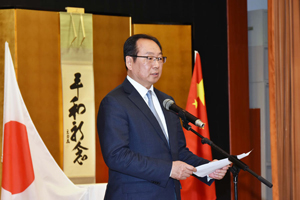 |
| CPAFFC Vice President SONG Jingwu |
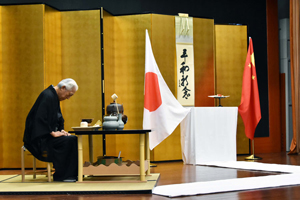 |
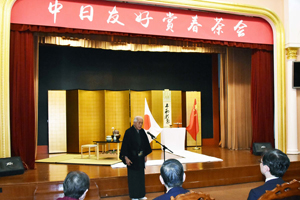 |
| A moment of deep concentration before making the tea | Afterwards, Daisosho addresses the attendees |
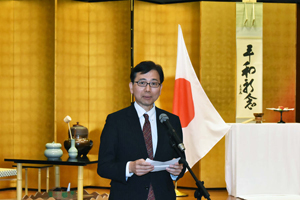 |
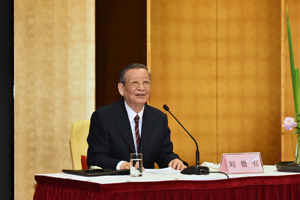 |
| Japanese Embassy Minister SHIKATA Noriyuki | Chinese Former Vice Minister of Culture LIU Deyou |
| Afterwards, outdoors by the Peace Bell, members of the Urasenke Tankokai Beijing Interest Group prepared matcha at a Misonodana style of tea making table unit, and as Daisosho provided explanations, they served traditional Japanese confections and matcha to the approximately one hundred guests who had been invited to this China-Japan Friendship Chakai. |
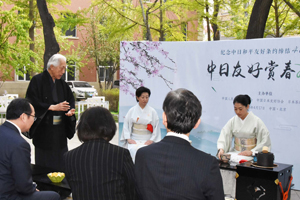 |
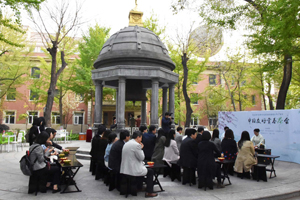 |
| Events in Shanghai Daisosho's trip to China in May was from the 13th to the 17th, and was to Shanghai. Here, in commemoration of the 40th anniversary of the China-Japan Peace and Friendship Treaty, there were three main events on his schedule. The first was a kencha-shiki on May 14th at Shanghai's famous Yufosi, the Jade Buddha Temple. A short video of this may be viewed on the temple's website at https://mp.weixin.qq.com/s/oTepGf22kJGcDsaMAhLRFQ. |
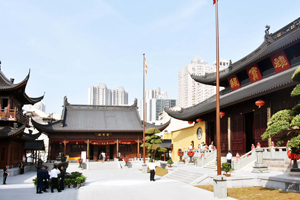 |
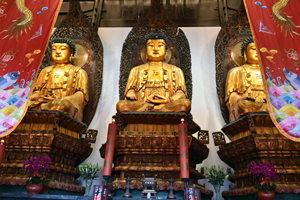 |
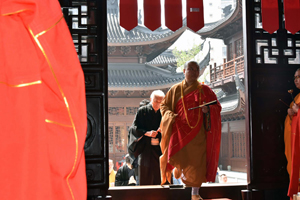 |
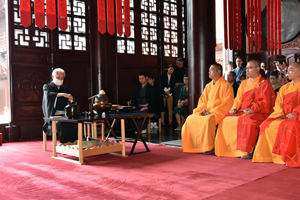 |
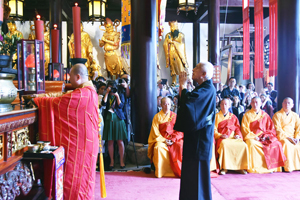 |
| In a corner of the temple's courtyard, members of the Urasenke Tankokai Shanghai Interest Group and other Urasenke groups in China prepared tea at a Misonodana, for temple visitors. Daisosho enjoyed exchanging ideas with Abbot JUE Xing and touring the temple's impressive museum and other facilities. That evening, the Tankokai Shanghai Interest Group hosted a reception for Daisosho at the Okura Garden Hotel Shanghai. Among the guests were Consul-General KATAYAMA Kazuyuki and wife, from the Consulate General of Japan in Shanghai. |
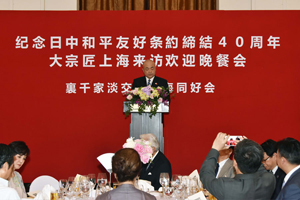 |
| Consul-General KATAYAMA Kazuyuki gives greeting speech |
| The second main event for Daisosho was a kencha-shiki and peace-sharing chakai (wago-no-chakai) program at the official residence of Consul-General Katayama the afternoon of May 15. There were approximately forty participants, including Vice President JING Ying of the Shanghai People's Association for Friendship with Foreign Countries, Yufosi Abbot JUE Xing, and Professor YAO Xinhong, who heads the Japanese Language Institute at Shanghai Jiao Tong University. Together with Consul-General Katayama and Mrs. Katayama, they were the attendees who shared the bowl of peace-sharing koicha prepared by Daisosho for the wago-no-chakai which followed the kencha-shiki tea dedication. Afterwards, all the other attendees were served usucha by members of Daisosho's Urasenke entourage. |
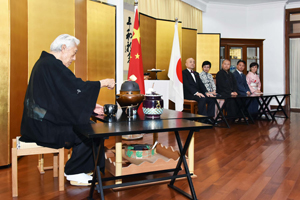 |
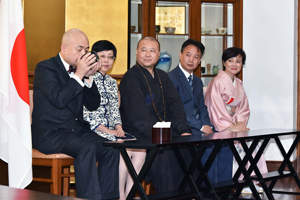 |
| Sharing the koicha are (from the left) Consul-General Katayama, Ms. JING Ying, Abbot JUE Xing, Prof. YAO Xinhong, and Mrs. Katayama. |
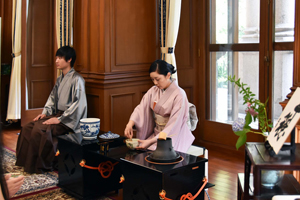 |
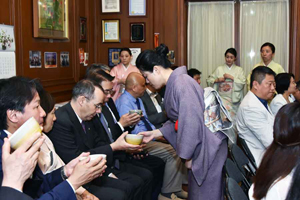 |
| The third main event on Daisosho's schedule was a talk and chado demonstration program at Shanghai Jiao Tong University's Japanese Language Institute the afternoon of May 16th. This program attracted an audience of approximately eight hundred people, including teachers and students at the university, and others interested in learning about Japan's chado culture. Preceding the program, they could drop by the tea service area for a bowl of usucha served by members of Urasenke's various official groups in China. |
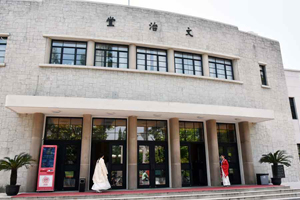 |
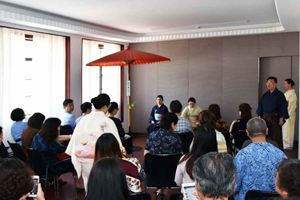 |
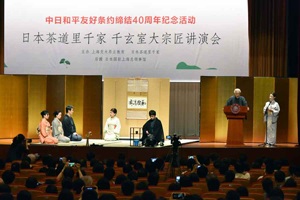 |
| The program lasted an hour and a half, and as Daisosho walked down the aisle to leave the auditorium when it was finished, he received a roaring ovation. |
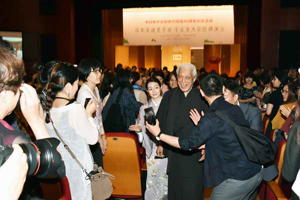 |
| HOME |